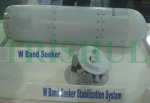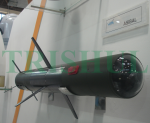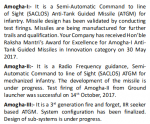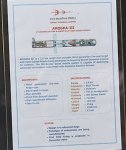The notion that you have to get literally on top of a sub in this day & age, in order to use these rockets suggests the obsolescence of both the concept and the rocket itself. The sooner we upgrade ourselves the better it is.Remember this ?
The navy had the vintage Russian rocket RGB-60 with a maximum range of 5.3km to fire from the RBU-6000 ASW rocket launcher. They wanted more range so the ARDE-HEMRL jointly built the ER-ASR(shown below) with a range of 8.5 km. The ER-ASR used the same airframe as that of the RGB-60 as it was also meant to be fired from the RBU-6000. The only changes were engine, fuel and thus thrust output.
View attachment 8660
It seems the increase in range often brings its own problems. The rocket when test fired was consistently missing the target. Remember its a non-guided rocket. So if it is flying off target, the reason isn't guidance failure, but design of the rocket. But the airframe of the rocket is the same as that of the RGB-60 which has worked well all these years. How would there be any problems with the airframe ?The inaccuracy as it turns out was due to increase in range. Well as ARDE put it :
View attachment 8661
Fascinating isn't it ? In the end all they had to do is slightly change the tail fins, the change was so small that it isn't even visible. That solved the problem.
View attachment 8662
Aerodynamics is a lovely subject, assuming you know what to do. Its not that lovely otherwise though.
You are using an out of date browser. It may not display this or other websites correctly.
You should upgrade or use an alternative browser.
You should upgrade or use an alternative browser.
That thing isn't going to be replaced anytime soon, the Navy loves it too much. What is likely going to happen is that other systems like the SMART, high-speed long-ranged torpedoes etc will restrict the scope of these rockets and render it unusable. Naval planners would at some point of time find themselves in a situation where they have to chose between the flexibility of having a few more cells of UVLS or having the RBU-6000.The notion that you have to get literally on top of a sub in this day & age, in order to use these rockets suggests the obsolescence of both the concept and the rocket itself. The sooner we upgrade ourselves the better it is.
Untill faced with such choices its unlikely to go away. Even then its only the top of the line combatants that will lose the RBU-6000s. Frigates, corvettes, patrol boat will continue using them.
Anyway, this debate has more to do with strategy then technology. I was just fascinated by the whole inaccuracy dilemma faced by the rocket.

Debateable.The notion that you have to get literally on top of a sub in this day & age, in order to use these rockets suggests the obsolescence of both the concept and the rocket itself. The sooner we upgrade ourselves the better it is.
Pinging @Fafnir
Elma ASW-600 - Wikipedia
The Modern Hedgehog
ComNavOps has called for the design and construction of a dedicated anti-submarine warfare (ASW) ship instead of a frigate. The reason for this is that our current ASW vessel is the Burke class destroyer which costs $2B each, conservatively, and is far too expensive to risk playing tag with submarines, especially small, silent, non-nuclear shallow water subs. Further, the Burkes are primarily anti-air warfare (AAW) vessels and do not train for ASW enough to be effective at it. That leads to the situation of a poorly trained and very expensive ship being asked to conduct ASW against an enemy that possesses most of the inherent advantages to begin with. We need an ASW vessel that is dedicated to ASW so that the ship and crew will be thoroughly trained and cheap enough to be expendable when playing tag with submarines.
However, in order to be effective, an ASW ship must have effective weapons. Currently, for close range encounters, the US Navy has only the standard Mk32 triple torpedo tube system (12.75”, 324mm) which launches lightweight Mk 46, Mk 50, and Mk 54 torpedoes. Unfortunately, these torpedoes have problems with their shallow water performance. The Mk 54, in fact, was developed in response to an urgent operational need resulting from shallow water performance problems demonstrated by the Mk 50. The Mk 54 has had its share of problems with DOT&E assessing it as “not operationally effective” in its 2014 Annual Report and states in the 2016 Annual Report that the Mk 54 “will remain not effective even with the Mod 1 fixes”.
The US Navy also has the vertical launch ASROC system but it is not a close range system. It has a maximum range of 15 miles. The minimum range is unknown but given that the weapon is a homing torpedo, it figures to be substantial.
Thus, the Navy’s only shipboard, close range ASW weapons are torpedoes which have faulty shallow water performance, are subject to minimum engagement limits, and are assessed as “not effective”.
As subs have grown quieter and more advanced around the world, and as US Navy ASW proficiency has atrophied, the likelihood that we will have more late detection, close range, unexpected encounters has increased. Further, shallow water ASW with its attendant noisy (poor sonar) conditions almost guarantees much closer detections. We need a quick reaction, anti-submarine weapon for those surprise, close range encounters. The Navy has had such weapons in the past but abandoned them with the advent of the ASW helicopter which was supposed to keep the ship at arm’s length from the submarine. In deep water, this is a reasonably valid concept but not in shallow water which is likely to be the more common ASW arena in the future.
Close range ASW weapons of the past include the iconic depth charge of WWII and the Hedgehog which was a mortar system that launched contact fused charges a few hundred feet in front of the ship. These weapons were eventually abandoned in favor of helicopters and homing torpedoes.

WWII Era Hedgehog
Today’s version of the Hedgehog was developed by the Soviet Navy and is called the RBU. The RBU is a short range rocket launcher which fires high explosive charges with either contact or depth fusing. The charges can be fired singly or in salvo. The launcher comes in various sizes which differ in the number of launching barrels, typically 6-12. Maximum range is 1000 yds – 6500 yds, depending on the version. The launcher is moveable in train and elevation and is rapidly and automatically reloadable from an integrated hatch at the base. Magazine capacity is up to around 100 reloads, depending on version. RBU’s were standard on all Soviet warships.

Russian RBU-1000
The RBU offers the capability of instantaneous attacks against very close contacts. The charges are immune to countermeasures and, in contact fuse mode, offer positive feedback on hits. The “dumb” nature of the free-sinking charges ensures that they offer no threat to the launching ship unlike homing torpedoes which can target the launching ship. To prevent self-targeting, torpedoes have minimum safe distance arming limits. Unfortunately, the minimum arming distance precludes engagement within that range. Thus, the Navy’s short range torpedo is not really short range or, rather, short range is a relative term. I’ve been unable to find a citation for the minimum safe arming distance for US torpedoes. Thus, an RBU can fill the gap between the minimum arming range of the torpedo and the ship.
An upgraded version of the RBU, the RPK-8, uses the RBU launcher with a 90R homing head charge which offers increased chance of a hit. The homing search radius is 130 m and the effective range is 600-4300 m and effective depth is 1000 m (1). Again, this demonstrates the drawback to homing capabilities in the form of minimum safe distance limits from the launch ship. Still, this may represent a balance of close range and enhanced kill probability via homing. The system is quick reaction with a combat ready time of 15 sec (1).
RBU rocket charges are also much cheaper and smaller than torpedoes which allows many more to be carried and used. In combat, when many questionable contacts will be prosecuted (no Captain will risk not prosecuting a questionable contact that could turn out to be real), the ability to use cheap, plentiful charges rather than scarce, expensive torpedoes could be a welcome option.

Russian Parchim Class Corvette Firing RBU-6000
Surface ships engaged in shallow water ASW or merely operating in shallow water will likely find themselves in surprise, close range encounters with non-nuclear submarines and a short range, quick reaction ASW weapon could provide the defense needed to survive the encounter. The small size and weight of the launcher makes it suitable for any ship and allows it to be added almost anywhere that a small deck penetration for the reloads can be accommodated.
The US Navy should give serious consideration to developing or obtaining such a weapon system. The combination of a small, dedicated, cheap ASW vessel and basic, reliable ASW weapons such as an RBU-Hedgehog along with lightweight torpedoes and various sonar sensors would provide the Navy with a viable, effective, and expendable ASW vessel well suited for shallow water operations.
On a side note, a time-fused version could possibly be adapted to torpedo defense by launching a salvo timed to drop in front of an incoming torpedo and explode – the anti-torpedo equivalent of CIWS.
Note: Russia offers the RPK-8 as an export weapon system – no development needed and it would be satisfying to “take” something from the Russians for a change!
These can't be related, can they ? Are we actually making a new naval AD missile ? naval version of XRSAM ? That would be great though.Found something interesting :
View attachment 8663
View attachment 8664
A naval AD missile that uses hot-launch. LRSAM ?
I thought the Israelis designed the VLS of the LRSAM. Was that done by the DRDO ? or is this a new missile ? There is no timeline that makes it difficult to guess.
There's a few other cool things about ASW mortars that torpedoes can't do. They're wicked counter-diver weapons with concussion charges collapsing cavities instantly resulting in a quick death for enemy divers, such as hostile naval special forces or sabotage units. China's Norinco makes a simple offing called the CS/AR-1. It's brutally effective, but is strictly counter-diver and has no secondary ASW capability like an RBU-6000 would.

ASW mortars are also fairly useful in clearing impact-susceptible mines or cutting mooring chains holding influence mines to their tether, either outright destroying, or floating the mine making sweeping easier. The British Hedgehog was used during the Normandy landings for mine and wire clearance by landing craft.

They're generally too slow to intercept torpedoes, but it's a theoretical capability.
My personal favorite thing about this is their use as a signalling charges due to their ability to also launch non-lethal charges. We'd occasionally drop a Terne noisecracker on Soviet/Russian submarines in our vicinity to let them know we knew where they were.

There's a lot of other fun and useful capabilities of ASW mortars that torpedoes can't match, so they still have their place.
So one thing that the article doesn't mention is why Russia, Finland and Sweden still use ASW mortars and that's because the Baltic, where each nation has a presence, has really poor sonar return quality due to its topography and depth, being a very shallow, and very busy water way with a lot of islands that limit torpedo range and engagement distance.


This is also why Sweden prefers to use wire-guided torpedoes, which get their course-correction updates from a submarine's fire-control system. It's more reliable.

ASW mortars like the ASW-601, Terne and RBU-6000 aren't fooled by undersea topography and can operated very effectively in shallow waters at a fraction of the cost and without sacrificing much in capability in congested waters.
The Indian Ocean is far more open then the Baltic Sea, so the necessity or viability of an ASW mortar is more limited, but in the more congested Eastern waters of the Andaman Sea or Indonesian Seaway still has a place.
I still like ASW mortars as a backup weapon given their low cost and limited profile. It's easy to slap them on anything that floats.
One technology demonstration project after the other. Made by scientists, for scientists. The chances of any of these making it to service are nil.
DRDO-VEM Technologies MPATGM is the only viable F&F ATGM project right now. Don't know why BDL is wasting it's funds on a duplication of effort in trying to create a new missile of what appears to be identical configuration.

Various munitions under development or trials by DRDO
1. Nipun - Soft target blast munition (development completed, offered for user trials)
2. Vibhav - Anti-tank point attack munition (lethality trials and desert trial completed)
3. Vishal - Anti-tank bar munition (dynamic trials with BMP/AFV, explosive train trials and desert trials completed)
4. Ulka - Jumping fragmentation munition (moulding trials ongoing)
5. Parth - Directional fragmentation module (demo trials completed, field trial ongoing)
6. ABG - 40mm low velocity Air Burst Grenade which can be fired from UBGL (flight tested in 2015, ABG fuze evaluated in dynamic trial with flash pallet in time mode)

These are basically mines?Anti tank and anti personnel?
There are some internal communications of DRDO, LDRE and RCI that fleetingly mentions the presence or development of a X-band AESA seeker. Now if this is true it would be revolutionary. With an AESA seeker nearly 2/3rd of the maximum range of the missile would be the NEZ. But that's still unsubstantiated, I've not seen any research papers/ journals on it yet.
So lets just wait. Any way it turns up the SFDR will be one hell of a missile when it comes.
NEZ is all about kinematics, not the seeker.
That's odd. I've read some articles on how pilots reduce the range at which they fire their missiles at the enemy in a heavy EW environment,NEZ is all about kinematics, not the seeker.
assuming the fired missile has a RF seeker. The logic seems that firing missiles from too far would cause the missiles to loose target lock. Thus in an electronically degraded environment effective NEZ reduces.
Conversely, if the seeker was jam proof or at least very difficult to jam(like an AESA seeker would be), it would enhance effective NEZ and prevent degradation under heavy jamming. Now we don't know if a AESA seeker is coming or not, so no point in debating that.
You are correct when you say NEZ is all about kinematics, that's how manufacturers calculate and put the numbers on the brochure. But in actual use the seeker does have a role to play. But I suppose I could have worded it better in the post that you quoted.
That's odd. I've read some articles on how pilots reduce the range at which they fire their missiles at the enemy in a heavy EW environment,
assuming the fired missile has a RF seeker. The logic seems that firing missiles from too far would cause the missiles to loose target lock. Thus in an electronically degraded environment effective NEZ reduces.
Conversely, if the seeker was jam proof or at least very difficult to jam(like an AESA seeker would be), it would enhance effective NEZ and prevent degradation under heavy jamming. Now we don't know if a AESA seeker is coming or not, so no point in debating that.
You are correct when you say NEZ is all about kinematics, that's how manufacturers calculate and put the numbers on the brochure. But in actual use the seeker does have a role to play. But I suppose I could have worded it better in the post that you quoted.
NEZ is a cone (which includes range, angle, velocity, burn time etc) within which the missile has the highest probability of interception in terms of kinematics against a target that's has been alerted. An active seeker operates well within the NEZ of a missile. For example, they claim the Meteor has 3x the NEZ of the Aim-120A/B, but whatever that 3x is, the Meteor's seeker only locks on when it's 15Km away or less from the target, no different than the Aim-120A/B. So the seeker has no relevance in determining the NEZ of a missile.
Look at the pic you posted in post #494. DRDO's seeker also has a lock on range of 13+Km.
Where the seeker does impact NEZ is when it comes to size and weight, because that can affect the amount of fuel you can carry and the thrust needed to lug that extra weight. AESA seekers are typically smaller and lighter than their MS counterparts. But this is subjective. If your engineering sucks compared to your competitor, then you can still make an AESA seeker that's bigger and heavier than your competitor's MS seeker.
Oh right. I totally didn't consider the fact that the initial lock is established by the fighter radar not the missile seeker, which activates later in flight. My bad.NEZ is a cone (which includes range, angle, velocity, burn time etc) within which the missile has the highest probability of interception in terms of kinematics against a target that's has been alerted. An active seeker operates well within the NEZ of a missile. For example, they claim the Meteor has 3x the NEZ of the Aim-120A/B, but whatever that 3x is, the Meteor's seeker only locks on when it's 15Km away or less from the target, no different than the Aim-120A/B. So the seeker has no relevance in determining the NEZ of a missile.
Look at the pic you posted in post #494. DRDO's seeker also has a lock on range of 13+Km.
Where the seeker does impact NEZ is when it comes to size and weight, because that can affect the amount of fuel you can carry and the thrust needed to lug that extra weight. AESA seekers are typically smaller and lighter than their MS counterparts. But this is subjective. If your engineering sucks compared to your competitor, then you can still make an AESA seeker that's bigger and heavier than your competitor's MS seeker.
VP M. Venkaiah Naidu visited Naval Science & Technological Laboratory(NSTL), DRDO at Vizag, Andhra Pradesh today on the occasion of Golden Jubilee Celebrations of NSTL.
Notice the fin shape of that missile ?

Its a naval Shaurya/K-15.
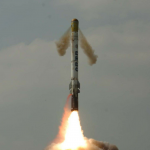
More photos :

The one with the red right is a drone(AUV something, I don't remember the name). More importantly, take a look to the left. Notice the yellow model of what seems to be a submarine, with that hump on the back its most certainly a SSBN. Looks somewhat similar to a Rusiian Typhoon to my eyes. What do you think ? @randomradio @Ashwin @vstol Jockey @Falcon et al.

Notice the fin shape of that missile ?

Its a naval Shaurya/K-15.

More photos :

The one with the red right is a drone(AUV something, I don't remember the name). More importantly, take a look to the left. Notice the yellow model of what seems to be a submarine, with that hump on the back its most certainly a SSBN. Looks somewhat similar to a Rusiian Typhoon to my eyes. What do you think ? @randomradio @Ashwin @vstol Jockey @Falcon et al.

Last edited:
VP M. Venkaiah Naidu visited Naval Science & Technological Laboratory(NSTL), DRDO at Vizag, Andhra Pradesh today on the occasion of Golden Jubilee Celebrations of NSTL.
Notice the fin shape of that missile ?
View attachment 9716
Its a naval Shaurya/K-15.
View attachment 9719
More photos :
View attachment 9717
The one with the red right is a drone(AUV something, I don't remember the name). More importantly, take a look to the left. Notice the yellow model of what seems to be a submarine, with that hump on the back its most certainly a SSBN. Looks somewhat similar to a Rusiian Typhoon to my eyes. What do you think ? @randomradio @Ashwin @vstol Jockey @Falcon et al.
View attachment 9718
@Gautam
I think you are right and I got it wrong initially
I followed up with the air water missile thing , and later realised that the yellow model on the left is not that.
It is most probably what you claimed could be in the first place , a model of a new SSBN
If one takes the front portion of model as the front portion of a SSBN , then the slant appendages are the fore fins. While the hump on the model is the section containing the SLBM silos . While the extended portion before the hump is the conning tower aka mast .
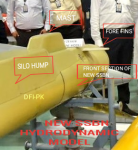
Last edited:
@Gautam
I think you are right and I got it wrong
I followed up with the air water missile thing , and later realised that the yellow model on the left is not that.
It is most probably what you claimed could be in the first place , a model of a new SSBN
If one takes the front portion of model as the front portion of a SSBN , then the slant appendages are the fore fins. While the hump on the model is the section containing the SLBM silos . While the extended portion before the hump is the conning tower aka mast .
Maybe this model is for hydrodynamic tests.
The fore fins remind me of the Royal Navy Vanguard class :

I see some Russian design influence, for obvious reasons. The hump is almost a bit too high. I do hope they are taking "inspiration" from the newer Russian subs like the Borei-class with its blended hump than the older subs.





